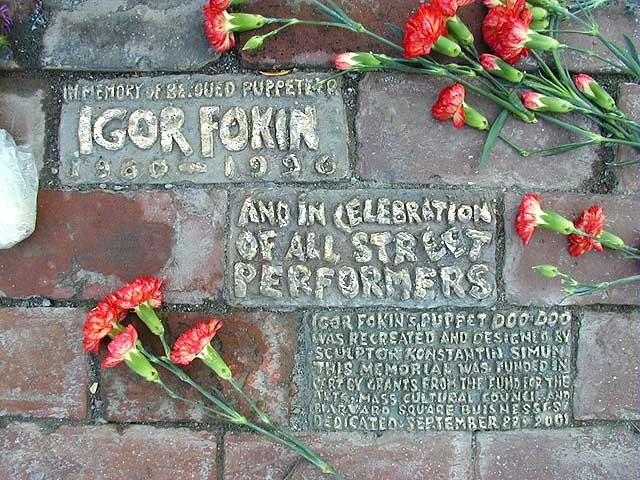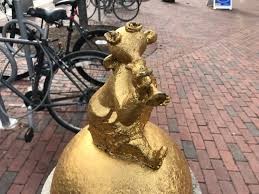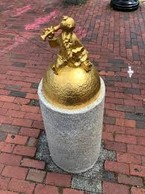Igor Fokin Memorial
Introduction
Text-to-speech Audio
Images
Memorial description on brick

Doo-Doo

Doo-Doo

Backstory and Context
Text-to-speech Audio
Igor Fokin Memorial is devoted to a Russian puppeteer, who became a symbol for One Brattle Square in Cambridge, Massachusetts. Fokin was born in 1960 in St. Petersburg Russia. He moved to Cambridge with the hopes of becoming a famous puppeteer and always performed at One Brattle Square in Cambridge. He worked until he had an unexpected heart failure at 36.
Fokin went to the St. Petersburg Theatrical Institute and studied theater design during his time in the Soviet Union. The reason he left Russia was due to the Communism regime that banned street art. The dissolution of the Soviet Union started in 1991 caused political and social conflicts in the country. A 1991 a coup attempted in order to oust Mikhail Gorbachev, who was the general secretary of the Communist Party. The violent outcomes of the coup, including a suicide, resulted in the establishment of temporary restrictions, including a ban on street art that forced Fokin to do his work underground and eventually to move to the United States to find freedom for his street art.
He came to the United States with only a couple of handmade puppets in 1993. He was joined by a theatre troupe on his journey to Cambridge. He constituted the one-man Wooden Horse Puppet Theatre, which is what he called the show that he put on. With the money he made from his daily shows in his so-called Puppet Theatre, he managed to support his wife and children.
After Igor Fokin’s unexpected death other street performers participated in shows at night to gather money which they gave to Fokin’s wife to support their family. This act gathered attention from people after a statue was erected at the spot where he always performed to always remember the positive influence he had on everyone who had a chance to watch him.
In Cambridge, his puppets were known for their different and unique personalities. He believed that even though he was the one controlling the puppets with the strings, the puppets had a mind of their own which helped Fokin steer them. He had 15 different puppets with very different backgrounds and personalities.
The most important puppet is "Doo-Doo" who was Fokin's and the crowd's favorite ("Wooden Horse" puppet theater (by Igor Fokin) - Symphony of Strings., 00:4:00-00:4:17). The memorial made is of "Doo-Doo". The puppet was created after a famous Russian story about a flute player who travels the world. In his act “Doo-Doo” plays his nose, which amuses the audience. The sculptor of the memorial Konstantin Simun, who is also from St. Petersburg, describes the process of making the sculpture in an interview as “It was important to make that chunk of bronze come to life, with personality.”.
The sculpture mold was made first from plasticine clay and then bronze metal was poured into the mold to create the final product."Doo-Doo" is captured as pretending his nose is an instrument. It is located in the middle of the square.
The memorial overall is memorializing a person who immigrated from a country, in which the conditions were tough for an artist, and managed to gather an audience in a country he came for the first time. During his time alive, how entertaining he was for people affected peoples lives. His usual audience got used to seeing him everyday at the same spot, thus when he passed away suddenly they felt a need to memorialize his once presence (The Puppeteer Film with Igor Fokin, 00:28:10- 00:28:29). For the people it was a routine that was lost from everywhere except their memory.
Sources
David Holmstrom, Staff writer of The Christian,Science Monitor. "A Legacy of a Thousand Dancing Strings Igor Fokin's Puppets Entranced Children and Traced Smiles on Harried Commuters Faces: ALL 09/25/96 Edition]." The Christian Science Monitor (pre-1997 Fulltext), Sep 25 1996, p. 12. ProQuest. Web. 11 Nov. 2019 .
“Igor Fokin.” Wikipedia, Wikimedia Foundation, 8 Dec. 2017, https://en.wikipedia.org/wiki/Igor_Fokin.
“Popular Russian Puppeteer Dies: News: The Harvard Crimson.” Popular Russian Puppeteer Dies | News, https://www.thecrimson.com/article/1996/9/24/popular-russian-puppeteer-dies-pfor-the/.
The Puppeteer Film With Igor Fokin , YouTube, https://www.youtube.com/watch?v=cJ2gizaqVw8.
Ugc. “Igor Fokin Memorial Sculpture.” Atlas Obscura, Atlas Obscura, 23 July 2012, https://www.atlasobscura.com/places/igor-fokin-memorial-scuplture.
"Wooden Horse" puppet theater (by Igor Fokin) - Symphony of Strings,YouTube, Hurdy Gurdy Films, https://www.youtube.com/watch?v=Jkn1c5083Co.
Igor Fokin Memorial Sculpture Project, https://www.igorfokin.com/memorial.html.
Ugc. “Igor Fokin Memorial Sculpture.” Atlas Obscura, Atlas Obscura, 23 July 2012, https://www.atlasobscura.com/places/igor-fokin-memorial-scuplture.
Ugc. “Igor Fokin Memorial Sculpture.” Atlas Obscura, Atlas Obscura, 23 July 2012, https://www.atlasobscura.com/places/igor-fokin-memorial-scuplture.
